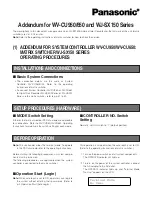
SIGNAMAX a.s.
Office: Vlarska 22, 627 00 Brno, CZ
T:+420 533 338 854 l F:+420 533 338 883 l www.signamax.eu
106
network devices are 802.1Q compliant).
Unfortunately, not all network devices are 802.1Q compliant. These devices are referred to
VLAN-unaware. 802.1Q devices are referred to VLAN-aware.
Prior to the adoption of 802.1Q VLANs, port-based and MAC-based VLANs were in
common use. These VLANs relied upon a Port VLAN ID (PVID) to forward packets. A
packet received on a given port would be assigned that port’s PVID and then be forwarded
to the port corresponding to the packet’s destination address (found in the Switch's
forwarding table). If the PVID of the port that received the packet different from the PVID of
the port that transmits the packet, the Managed Switch will drop the packet.
Within the Managed Switch, different PVIDs mean different VLANs (remember that two
VLANs cannot communicate without an external router). Therefore, VLAN identification
based upon the PVIDs cannot create VLANs that extend outside a given switch (or switch
stack).
Every physical port on a switch has a PVID. 802.1Q ports are also assigned a PVID for use
within the Switch. If no VLANs are defined on the Managed Switch, all ports are then
assigned to a default VLAN with a PVID equal to 1. Untagged packets are assigned the
PVID of the port on which they were received. Forwarding decisions are based upon this
PVID, in so far as VLANs are concerned. Tagged packets are forwarded according to the
VID contained within the tag. A PVID is assigned to the untagged packet, but the PVID is
not used to make packet-forwarding decisions, the VID is.
VLAN-aware switches must keep a table so as to relate PVIDs within the Switch to VIDs on
the network. The Managed Switch will compare the VID of a packet to be transmitted with
the VID of the port that is to transmit the packet. If the two VIDs are different, the Managed
Switch will drop the packet because the existence of the PVID for untagged packets and the
VID for tagged packets, VLAN-aware and VLAN-unaware network devices can coexist on
the same network.
A switch port can only have one PVID; however, it can have as many VIDs as the Switch
has memory in its VLAN table to store them.
Because some devices on a network may be VLAN-unaware, a decision must be made at
each port on a VLAN-aware device before packets are transmitted - should the packet to be
transmitted have a tag or not? If the transmitting port is connected to a VLAN-unaware
device, the packet should be untagged. If the transmitting port is connected to a VLAN-
aware device, the packet should be tagged.
4.4.7.3 Introduction to Q-in-Q
The IEEE 802.1Q double tagging VLAN is also referred to Q-in-Q or VLAN stacking (IEEE
802.1ad). Its purpose is to expand the 802.1q VLAN space by tagging the inner tagged
packets. In this way, a “double-tagged” frame is created so as to separate customer traffic
within a service provider network. As shown below in “Double-Tagged Frame” illustration, an
outer tag is added between source destination and inner tag at the provider network’s edge.
This can support C-VLAN (Customer VLAN) over Metro Area Networks and ensure
complete separation between traffic from different user groups. Moreover, the addition of
double-tagged space increases the number of available VLAN tags which allow service
















































